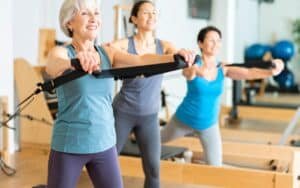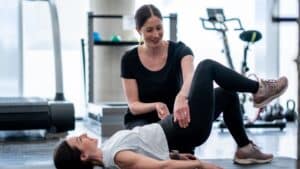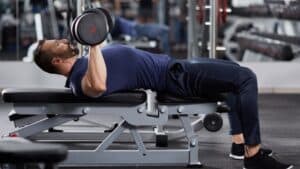It’s important to understand that you cannot spot reduce fat in a specific area of your body, including your lower belly. However, doing exercises that target your core muscles can help strengthen and tone your abdominal muscles, which can help give the appearance of a flatter stomach. Lower belly fat exercises have several benefits beyond just targeting the specific area.
Here are some of the benefits of incorporating lower belly fat exercises into your workout routine:
Increased Muscle Strength: Lower belly fat exercises help to strengthen and tone the muscles in the lower abdominal area, which can improve your overall core strength and stability.
Improved Posture: A stronger core from lower belly fat exercises can help to improve your posture and reduce the risk of back pain and injury.
Better Balance: A strong core also helps to improve your balance, which can be beneficial for activities like sports or just everyday activities like walking or climbing stairs.
Reduced Risk of Disease: Reducing belly fat, including lower belly fat, has been linked to a lower risk of heart disease, diabetes, and other health conditions.
Boosted Metabolism: Engaging in regular exercise, including lower belly fat exercises, can help to boost your metabolism and burn more calories, even at rest.
Improved Body Confidence: Seeing results from lower belly fat exercises can boost your body confidence and help you feel better about yourself overall.
Here are some effective exercises that target the lower belly fat:
Scissor Kicks
Scissor Kicks is a popular abdominal exercise that targets the lower abs and hip flexors. Here’s how to perform Scissor Kicks:
- Lie flat on your back with your arms at your sides and your legs straight out in front of you.
- Lift your legs off the ground about six inches and keep them straight.
- Begin the exercise by raising one leg until it is perpendicular to the ground while lowering the other leg until it is hovering just above the floor.
- Switch legs, raising the other leg and lowering the first leg.
- Continue alternating your legs in a scissor-like motion, with each leg passing the other in mid-air, for the desired number of repetitions or time.
- Remember to engage your core throughout the exercise and to keep your lower back pressed into the ground.
You can do Scissor Kicks as part of your regular workout routine, or incorporate it into a core-specific workout. Aim for 2-3 sets of 10-15 repetitions, or hold for 30-60 seconds.
Plank
The plank is a simple but effective exercise that targets the core muscles, including the abdominals, lower back, and hip muscles. Here are the steps to perform a basic plank exercise:
- Start by positioning yourself face down on the floor with your elbows and forearms on the ground, and your hands flat in front of you.
- Extend your legs back so that your toes are touching the floor and your body forms a straight line from your head to your heels.
- Engage your core muscles and hold this position for as long as possible.
- Keep your hips level and avoid sagging or lifting your hips.
- Focus on maintaining a neutral spine position, with your head and neck in line with your body.
- Breathe deeply and steadily throughout the exercise.
To increase the intensity of the plank, you can try variations such as the side plank, high plank, or plank with leg lifts. Hold the position for 30 seconds to a minute or longer, depending on your fitness level. Repeat for 2-3 sets. The plank can be included in your regular exercise routine or as part of a core workout.
Leg Raises
Leg raises are a great exercise to target your lower abs, hip flexors, and quadriceps. Here are the steps to perform leg raises:
- Lie flat on your back with your legs straight and your arms at your sides.
- Engage your core muscles and lift your legs off the ground, keeping them straight and together.
- Slowly raise your legs until they are perpendicular to the ground or as high as you can go while maintaining control.
- Hold for a second or two at the top of the movement, then slowly lower your legs back down to the starting position.
- Repeat for the desired number of repetitions.
To increase the intensity of the exercise, you can add ankle weights, perform the exercise on a decline bench, or do the exercise with your legs crossed. You can also try variations such as side leg raises or reverse leg raises, which target different areas of the lower body. Aim for 2-3 sets of 10-15 repetitions, or as many as you can perform with proper form. Remember to keep your core engaged throughout the exercise and avoid arching your back.
Bicycle Crunches
Bicycle crunches are a great exercise to work your abs, obliques, and hip flexors. Here are the steps to perform bicycle crunches:
- Lie flat on your back with your hands behind your head and your knees bent.
- Lift your shoulders off the ground, engaging your abs.
- Bring your right knee towards your chest while straightening your left leg, and rotate your torso to touch your left elbow to your right knee.
- Switch sides, bringing your left knee towards your chest while straightening your right leg, and touch your right elbow to your left knee.
- Continue alternating sides, pedaling your legs in a bicycle motion while touching your opposite elbow to your knee.
- Remember to keep your core engaged and your lower back pressed into the ground throughout the exercise.
To increase the intensity of the exercise, you can lift your legs higher, perform the exercise faster, or hold weights in your hands. Aim for 2-3 sets of 10-15 repetitions, or as many as you can perform with proper form. Bicycle crunches can be included in your regular exercise routine or as part of a core workout.
Russian Twists
Russian twists are a popular exercise that target the obliques, abs, and lower back. Here are the steps to perform Russian twists:
- Start by sitting on the ground with your knees bent and your feet flat on the floor.
- Lean back slightly and engage your core muscles.
- Lift your feet off the ground so that your knees are bent at a 90-degree angle.
- Hold a weight or a medicine ball with both hands at chest height.
- Twist your torso to the right, bringing the weight or ball to your right side.
- Twist your torso to the left, bringing the weight or ball to your left side.
- Repeat the twisting motion for the desired number of repetitions or time.
To increase the intensity of the exercise, you can hold the weight or ball further away from your body, extend your legs, or lift your feet higher off the ground. Aim for 2-3 sets of 10-15 repetitions, or as many as you can perform with proper form. Russian twists can be included in your regular exercise routine or as part of a core workout. Remember to keep your core engaged throughout the exercise and to breathe deeply and steadily.
Mountain Climbers
Mountain climbers are a great exercise to work your abs, obliques, hip flexors, and shoulders. Here are the steps to perform mountain climbers:
- Start in a high plank position with your hands shoulder-width apart and your body in a straight line from head to heels.
- Engage your core muscles and lift your right foot off the ground, bringing your knee towards your chest.
- Quickly switch legs, bringing your left foot forward while sending your right foot back.
- Continue alternating legs in a running motion, as if you are climbing a mountain.
- Keep your core engaged and your hips level throughout the exercise.
- Breathe deeply and steadily throughout the exercise.
To increase the intensity of the exercise, you can perform the exercise faster or hold a plank position for a few seconds in between each leg switch. Aim for 2-3 sets of 30-60 seconds, or as many as you can perform with proper form. Mountain climbers can be included in your regular exercise routine or as part of a high-intensity interval training (HIIT) workout.
High knees
High knees are a plyometric exercise that can help to improve cardiovascular fitness, leg strength, and endurance. Here are the steps to perform high knees:
- Stand up straight with your feet hip-width apart and your arms at your sides.
- Begin by jogging in place, lifting your knees up high towards your chest as quickly as possible.
- Swing your arms in a running motion to help increase your speed and momentum.
- Try to keep your core engaged and your back straight throughout the exercise.
- Continue for the desired number of repetitions or time.
To increase the intensity of the exercise, you can perform the exercise faster or add ankle weights. You can also perform high knees as part of a cardio circuit, alternating with other exercises such as jumping jacks or burpees. Aim for 2-3 sets of 30-60 seconds, or as many as you can perform with proper form. Remember to breathe deeply and steadily throughout the exercise.
Kettlebell swings
Kettlebell swings are a compound exercise that can work multiple muscle groups, including the glutes, hamstrings, quads, core, and upper back. Here are the steps to perform kettlebell swings:
- Stand with your feet shoulder-width apart and place a kettlebell on the ground in front of you.
- Hinge at the hips and reach down to grab the kettlebell with both hands.
- Stand up straight, lifting the kettlebell with both hands, and swing it back between your legs.
- Hinge at the hips and knees, and then powerfully swing the kettlebell up to chest height, using your glutes and hamstrings to propel the movement.
- Keep your arms straight throughout the movement and engage your core muscles to stabilize your body.
- Allow the kettlebell to swing back down between your legs and then repeat the movement for the desired number of repetitions or time.
To increase the intensity of the exercise, you can use a heavier kettlebell, perform the exercise faster, or perform single-arm swings. Aim for 2-3 sets of 10-15 repetitions, or as many as you can perform with proper form. Kettlebell swings can be included in your regular exercise routine or as part of a full-body workout.
Deadlifts
Deadlifts are a compound exercise that target the muscles in your back, legs, and hips. Here are the steps to perform a deadlift:
- Stand with your feet shoulder-width apart and place a barbell in front of you with weights that you can comfortably lift.
- Squat down to grab the bar with an overhand grip, your hands slightly wider than shoulder-width apart.
- Engage your core and leg muscles as you stand up, lifting the bar off the ground and keeping it close to your body.
- Keep your back straight and your shoulders pulled back as you lift the bar.
- Once you reach a standing position, slowly lower the bar back down to the ground by hinging at the hips and lowering the bar down your shins.
To increase the intensity of the exercise, you can use heavier weights or perform different variations of the deadlift, such as the Romanian deadlift or sumo deadlift. It’s important to start with lighter weights and focus on proper form before progressing to heavier weights. Aim for 2-3 sets of 6-10 repetitions, or as many as you can perform with proper form. Deadlifts can be included in your regular exercise routine or as part of a full-body workout.
Lying Alternate Toe Taps
Lying alternate toe taps are a core exercise that can help to strengthen the abs, obliques, and lower back. Here are the steps to perform lying alternate toe taps:
- Lie down on your back with your legs extended straight up towards the ceiling and your arms at your sides.
- Engage your core muscles and lift your head, neck, and shoulders off the ground.
- Slowly lower your right leg towards the ground while keeping your left leg extended straight up.
- Tap your right foot lightly on the ground and then bring it back up to meet your left foot.
- Repeat the movement with your left leg, tapping your left foot on the ground and then bringing it back up to meet your right foot.
- Continue alternating legs for the desired number of repetitions or time.
To increase the intensity of the exercise, you can lower your legs closer to the ground or perform the exercise with ankle weights. Aim for 2-3 sets of 10-15 repetitions, or as many as you can perform with proper form. Lying alternate toe taps can be included in your regular exercise routine or as part of a core workout. Remember to breathe deeply and steadily throughout the exercise.
Crunches
Crunches are a popular exercise for targeting the abdominal muscles, specifically the rectus abdominis. Here are the steps to perform crunches:
- Lie on your back with your knees bent and your feet flat on the ground, hip-width apart.
- Place your hands behind your head or cross them over your chest.
- Engage your core muscles and lift your head, neck, and shoulders off the ground, curling your chest towards your knees.
- Keep your elbows out to the sides of your head, but avoid pulling on your neck with your hands.
- Hold the contraction for a moment, and then slowly lower your upper body back down to the ground.
To increase the intensity of the exercise, you can perform the exercise on an incline bench or with a weight held against your chest. Aim for 2-3 sets of 10-15 repetitions, or as many as you can perform with proper form. Crunches can be included in your regular exercise routine or as part of a core workout. Remember to breathe deeply and steadily throughout the exercise and to avoid straining your neck or lower back.
Jackknife Crunch
Jackknife crunches are an advanced exercise that target the entire abdominal area, including the rectus abdominis and the obliques. Here are the steps to perform a jackknife crunch:
- Lie down on your back with your arms extended overhead and your legs straight.
- Engage your core muscles and lift your arms and legs off the ground at the same time, reaching your hands towards your toes.
- Keep your legs straight as you lift them up towards the ceiling.
- Once you reach the top of the movement, pause briefly and then slowly lower your arms and legs back down to the ground.
- Repeat the movement for the desired number of repetitions or time.
To increase the intensity of the exercise, you can hold a weight between your hands or add ankle weights to your legs. Aim for 2-3 sets of 10-15 repetitions, or as many as you can perform with proper form. Jackknife crunches can be included in your regular exercise routine or as part of a core workout. Remember to breathe deeply and steadily throughout the exercise and to avoid straining your neck or lower back.
Conclusion
Exercises targeting the lower belly can be effective in strengthening and toning the abdominal muscles, which can lead to a reduction in lower belly fat over time. A combination of exercises such as planks, crunches, mountain climbers, and kettlebell swings can help to work various areas of the lower abdominal muscles. To see significant changes, these exercises must be accompanied by a healthy diet and overall weight loss, as spot reduction of fat is not possible. Furthermore, it is important to focus on maintaining proper form during these exercises to avoid injury and achieve optimal results. Incorporating these exercises into a regular workout routine can help to achieve a toned and flat stomach while improving overall health and fitness.






